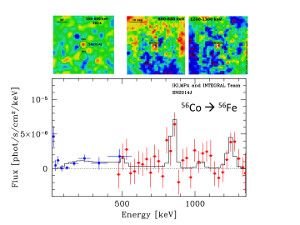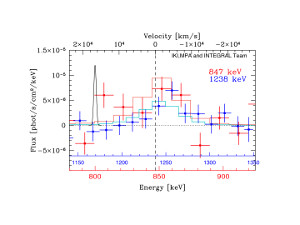|
|  |
A Type Ia supernova (SNIa) is believed to be the thermonuclear explosion of a
white dwarf star - the stellar remnant of a normal star, such as our Sun, after
the star has exhausted its hydrogen fuel. Such a white dwarf consists mainly of
carbon and oxygen - the ashes of hydrogen and helium burning - and during the
supernova explosion large amounts of a radioactive nickel isotope (56Ni) are
produced. The subsequent decay chain from nickel to cobalt and eventually iron
(see Fig. 1) releases huge amounts of energy in the form of highly energetic
gamma-ray photons. These are re-processed in the expanding material ejected by
the explosion, giving rise to a powerful optical emission, which has become an
invaluable tool in cosmological studies as a distance indicator.
Despite a long history of observations and simulations, the detailed physics of
a SNIa explosion and the evolutionary path, which the compact object has to
follow towards the explosion, remain a matter of debate. The majority of models
predict that during the first 10-20 days after the explosion the ejected
material is opaque for gamma-ray lines due to Compton scattering. As the ejected
material becomes progressively more transparent, a large fraction of gamma-rays
can finally escape.
However, gamma-ray emission from SNIa's has never been detected, primarily
because the objects were too far away. More than 27 years ago, hard X-rays and
direct gamma-rays were detected from the supernova SN1987A in the Large
Magellanic Cloud; this was the nearest core collapse supernova (a Type II) in
recent history. Even though Type Ia events are intrinsically brighter, they are
more rare and have remained elusive in gamma-rays until now.
"In August 1987 we were very lucky", remembers MPA Director Rashid Sunyaev,
"when we - together with the group of Prof. Joachim Trümper at the Max Planck
Institute for Extraterrestrial Physics - detected extremely unusual hard X-Ray
radiation (Fig. 2) coming from the Type II supernova SN1987A. Back then, we were
able to use X-Ray devices aboard the MIR space station for these observations.
And we are lucky again this year: three million seconds of INTEGRAL spacecraft
observations permitted us to detect a Type Ia supernova with huge luminosity in
two narrow gamma-ray lines."
On 15 January 2014, a SNIa exploded in the spiral galaxy M82 and was discovered
by S.J. Fossey and a team of students from University College London a few days
later. At a distance of just over 10 million light-years, this is the nearest
SNIa in at least four decades. The proximity of this supernova, dubbed SN2014J,
triggered many follow-up observations, including those by ESA's gamma-ray
observatory INTEGRAL. The data, taken by INTEGRAL between 50 and 100 days after
the explosion, clearly show the two brightest of the expected cobalt gamma-ray lines at
847 and 1238 keV (see Fig. 3). Additionally, the flux at lower energies (200-400
keV) agrees with theoretical predictions as well.
"The line fluxes suggest that a large amount of radioactive nickel was
synthesized during the explosion, more than half the mass of our Sun," explains
Eugene Churazov, the lead author of this study. Both observed gamma-ray lines
are strongly broadened due to Doppler effect. This suggests that the cloud of
radioactive materials expands with velocities of about 10000 km/s. Initially,
the material is so dense that the gamma-rays produced by the radioactive decay
of nickel to cobalt (with a typical time scale of 9 days) loose most of their
energy due to Compton scattering and recoil effect. The subsequent decay of
cobalt to iron takes much longer, about 111 days. During this time the ejected
material becomes increasingly transparent, ultimately allowing the gammy-rays to
escape and making SNIa a long-lasting source of gamma-rays.
Further comparisons with several popular theoretical models, based on detailed
calculations of the nucleosynthesis processes during the explosion, reveal good
agreement of the SN2014J data with "canonical" models of SNIa explosions, where
a white dwarf reaches the critical Chandrasekhar-mass and detonates. Strongly
sub-Chandrasekhar-mass models or pure detonation models can already be ruled out
by these observations.
The overall, good agreement with the "canonical" models shows that in gamma-rays
SN2014J looks like a proto-typical SNIa, even if strong and complicated
extinction in the optical band makes the analysis challenging. "The INTEGRAL
data provide unambiguous proof that SN2014J and therefore Type Ia supernovae are
a thermonuclear explosion," concludes Eugene Churazov. "The data are consistent
with the explosion of a white dwarf just massive enough to be unstable to
gravitational collapse, but do not exclude merger scenarios that fuse comparable
amounts of nickel."
E.Churazov, R.Sunyaev, J.Isern, J.Knödlseder, P.Jean, F.Lebrun, N.Chugai,
S.Grebenev, E.Bravo, S.Sazonov, M.Renaud
Contact:
Dr. Eugene Churazov
Max-Planck-Institut für Astrophysik, Garching
Telefon: +49 98 30000-2219
E-Mail: echurazov mpa-garching.mpg.de mpa-garching.mpg.de
Original publications:
E.Churazov, R.Sunyaev, J.Isern, J.Knödlseder, P.Jean, F.Lebrun, N.Chugai,
S.Grebenev, E.Bravo, S.Sazonov, M.Renaud 56CO gamma-ray emission lines from the
type Ia supernova SN 2014J,  Nature, Aug 28th, 2014 Nature, Aug 28th, 2014
R. Sunyaev, A. Kaniovsky, V. Efremov, M. Gilfanov, E. Churazov, S. Grebenev, A.
Kuznetsov, A. Melioranskiy, N. Yamburenko, S. Yunin, D. Stepanov, I. Chulkov, N.
Pappe, M. Boyarskiy, E. Gavrilova, V. Loznikov, A. Prudkoglyad, V. Rodin, C.
Reppin, W. Pietsch, J. Engelhauser, J. Trümper, W. Voges, E. Kendziorra, M.
Bezler, R. Staubert, A. C. Brinkman, J. Heise, W. A. Mels, R. Jager, G. K.
Skinner, O. Al-Emam, T. G. Patterson & A. P. Willmore.Discovery of hard
X-ray emission from supernova 1987A, Nature 330, 227 - 229 (19 November 1987)
|






 mpa-garching.mpg.de
mpa-garching.mpg.de